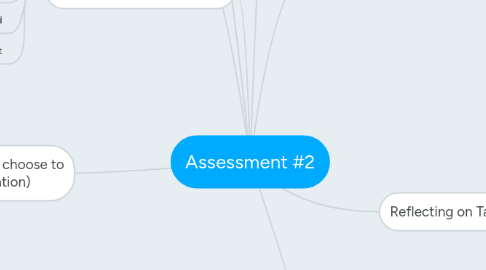Assessment #2
by Becca L

1. Feelings about Assessment
1.1. Scared
1.2. Nervous
1.3. High stakes
1.4. Worried
1.5. Upset
2. RECORDING (how we choose to collect and analyze data)
2.1. Uses of Assessment
2.1.1. to determine SPED services
2.1.2. to determine interventions
2.1.3. to check for growth
2.1.4. to measure achievement
2.1.5. for teacher's evaluations
2.2. keeping records of test/task results.
2.3. collecting evidence of students’ understanding and thinking
3. REPORTING (how we choose to communicate information)
3.1. using representative examples of students’ work or performance to provide information about student learning
3.2. engaging students in reflecting on their learning
3.3. students assessing work produced by themselves and by others
3.4. developing clear rubrics
3.5. identifying exemplar student work
4. Assessment Strategies
4.1. observations
4.2. performance assessments
4.3. process-focused assessments
4.4. selected response
4.5. open-ended tasks
5. Assessment Tools
5.1. rubrics
5.2. exemplars
5.3. checklists
5.4. anecdotal records
5.5. continuums
6. Validity of Assessments
6.1. age appropriate?
6.2. growth?
6.3. target data?
6.4. necessary?
7. ASSESSING (how we discover what the students know and have learned)
7.1. Papers/writing
7.2. Projects
7.3. Tests
7.4. Quizzes
7.5. Online Assessments
7.6. Observations
7.7. Formative
7.8. Summative
7.9. documenting learning processes of groups and individuals
8. Reflecting on Tasks
8.1. Have the tasks provided ample information to allow a judgment to be made about whether the purposes or objectives have been met?
8.2. What does the students’ performance reveal about their level of understanding?
8.3. Have any unexpected results occurred?
8.4. What changes should be made in the assessment procedure?
8.5. How should the teaching and learning process be modified as a result of the assessment?


